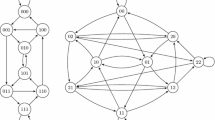Abstract
A correspondence is developed between permutations and two-dimensional digraphs. When the graphs are also required to be completely bipartite composite (CBC), their permutations then correspond to a class called the Baxter permutations. A permutation can be tested for the Baxter condition by a linear time processing of its digraph. This processing involves a pair of traversals of the digraph and is made possible by exploiting a relationship with the syntactical graphs used in language theory.
Similar content being viewed by others
References
R. Alter and J. M. Hart, “Enumerating syntactical graphs and lattices of derivations,”Internat. J. Comp. Inform. Sci. 8 (4): 261–277 (1979).
G. Baxter, “On fixed points of the composite of computing functions,”Proc. Amer. Math. Soc. 15:851–855 (1964).
W. M. Boyce, “Generation of a class of permutation associated with commuting functions,”Math. Algorithms 2:19–26 (1967).
W. M. Boyce, “Baxter permutations and functional composition” (submitted for publication).
F. R. K. Chung, R. L. Graham, V. E. Hoggatt and M. Kleiman, “The number of Baxter permutations,”J. Combinatorial Theory (Series A)24:382–394 (1978).
J. M. Hart, “Derivation languages and syntactical categories,”Inform. Control 28:204–220 (1975).
J. M. Hart, “Doubly keyed lists for binary relations,”Proceedings of the CISS, The Johns Hopkins University, Baltimore, Maryland (1979), pp. 257–261.
J. M. Hart and R. Alter, “Counting Baxter Permutations with Doubly Ordered Graphs,” TR #46-78, Department of Computer Science, University of Kentucky, Lexington, Kentucky (1978).
T. Kamimura and G. Slutzki,Parallel and Two-Way Recognizers of Directed Acyclic Graphs, Lecture Notes in Computer Science #74 (Springer-Verlag, Berlin, 1979), pp. 317–325.
E. Horowitz and S. Sahni,Fundamentals of Data Structures (Computer Science Press, Woodland Hills, California, 1976).
J. Valdes, “Parsing Flowcharts and Series-Parallel Graphs,” Ph. D. Dissertation, Department of Computer Science, Stanford University, Stanford, California (Aug. 1978).
J. Valdes, R. E. Tarjan and E. L. Lawler, “The recognization of series parallel digraphs,”Proceedings of the Eleventh Annual Symposium on the Theory of Computing (1979), pp. 1–12.
Author information
Authors and Affiliations
Rights and permissions
About this article
Cite this article
Hart, J.M. Fast recognition of Baxter permutations using syntactical and complete bipartite composite dag's. International Journal of Computer and Information Sciences 9, 307–321 (1980). https://doi.org/10.1007/BF00978163
Received:
Revised:
Issue Date:
DOI: https://doi.org/10.1007/BF00978163




